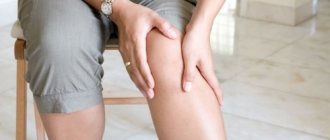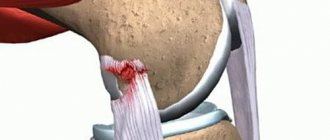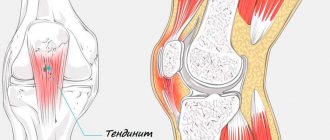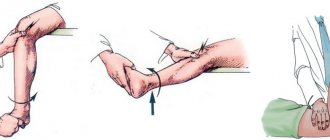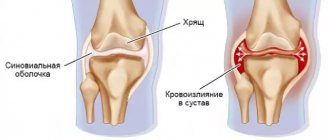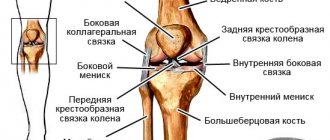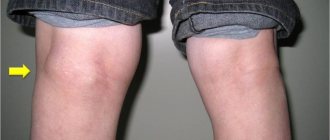Meniscopathy of the knee joint is a common pathology, which is treated by traumatologists and orthopedists. The disease is common among athletes and people with increased physical labor. The predominant age category is from 18 to 40 years. The problematic condition of the knee menisci is more often suffered not by women, but by men (ratio 3:2), since they work more with heavy weights. If on the eve of the development of the inflammatory process inside the meniscus there was no obvious damage to the knee joint, the first 2 stages of the disorder occur in a form hidden for the patient. Meniscopathy is difficult to diagnose - this feature causes complex treatment, since the disorder is detected late.
What are the types of meniscal injuries?
In 75% of cases of knee injuries, tears of the meniscus of the knee joint are diagnosed. Depending on the origin, there are several types of meniscus tears.
Meniscus injuries . The menisci can be damaged as a result of a direct or combined blow to the knee joint. In such cases, the shin rotates, which damages the meniscus. Typically injuries occur as a result of:
• deep squats with weights, including when the athlete squats for a long time in the bottom position; • jumping on hard or uneven surfaces; • long walks in single file; • falls on a bent leg; • direct physical blows to the knee joint. Separately, there are chronic lesions that occur with frequent injuries and are found in professional athletes.
The causes of damage may be careless movements, prolonged exposure to an uncomfortable position, or other stress on the cartilage pad. At a young age, such injuries usually occur as a result of professional and amateur sports - volleyball, basketball, badminton, running, gymnastics, wrestling. The meniscus is not designed to withstand such loads; in professional athletes, it can withstand them only by strengthening the muscular-ligamentous apparatus. However, when the impact is decompensated (for example, unsuccessful eversion), it injures the meniscus with the same effect in both trained and untrained people.
Degenerative ruptures . This type of injury is caused by degenerative changes in the knee joint. They are caused by: • chronic diseases – arthritis, arthrosis; • gout; • age-related degeneration of cartilage tissue; • repeated microtraumas.
At risk are athletes, people over 50 years of age and people with chronic diseases. In athletes, damage to the meniscus of the knee joint most often occurs during training. Constant microtraumas disrupt circulation in the affected area, and as a result, any overstrain leads to injury. This is especially often observed among roller skaters, football players, figure skaters, basketball players, skiers, and dancers. Damage to the lateral meniscus can cause a quick turn, a poor landing, or a sudden sudden strain.
After 50 years, approximately 20% of women and more than 30% of men experience dystrophic changes in the menisci of the knee joint. Over the age of 70 – every second person. This is due to the fact that with age, cartilage tissue becomes thinner, so the likelihood of damage to the meniscus of the knee joint increases. The same problem applies to people with chronic diseases. Pathological changes in the menisci of the knee joint can be caused by excess weight, gout, arthrosis, and rheumatism. Diseases lead to tissue swelling, thinning of collagen fibers and cause inflammatory processes. Ruptures are the most common damage. However, they are rarely isolated: in most cases, meniscal tears also affect other structures - ligaments, muscles, tendons, cartilage. They can be:
Full . The joint becomes immobilized due to the fact that the gap between the tendons and the joint capsule sharply narrows. Any attempt to move the leg causes sharp pain in the knee joint. Partial . They are asymptomatic or accompanied by dull pain, swelling, and decreased mobility in the joint.
In addition, tears are classified according to other criteria: which meniscus is affected (internal or external), by the location of the damage (body, anterior or posterior horn, complex) and shape (flap, “watering can handle” and others). Osteopathy looks at the whole body as a whole, so we consider any problems with the menisci of the knee joint as a failure in the entire system. Therefore, in addition to the above reasons (trauma, degenerative disorders), we are always looking for others. For example, a malfunction in the general biomechanics of the body leads to overloads in the menisci and the entire joint. Thus, curvature of the spine can cause skeletal asymmetry and uneven loads on the menisci.
Scoliosis leads to a misalignment of the hip joint, so one leg is lower than the other. A difference in position of even 1 cm causes increased stress and, therefore, permanent microtrauma in the menisci.
Pathogenesis
The menisci are a particularly vulnerable part of the knee joint. These anatomical structures play an important mechanical role, and their damage affects the general functional state of the limb and the patient’s motor activity. Being part of the capsular-ligamentous apparatus, the menisci provide stabilization of the knee joint during flexion/extension; help to transfer and correctly (safely) distribute the load from the femur to the tibial plateau.
As part of the musculoskeletal system, the meniscus performs 5 main functions:
- softens and absorbs shock between articular surfaces;
- stabilizes joint mobility;
- evenly distributes the axial load on the surface of the thigh and lower leg;
- performs a suction function.
85% of clinical cases of meniscopathy of the knee joint are the consequences of traumatic effects that occur acutely (once) or chronically (permanently). Only in 15% of cases the disease is the result of progressive pathology within the joint. Often such phenomena are degenerative-dystrophic in nature.
Symptoms and severity of meniscal tears
Immediately after the injury, the victim experiences acute symptoms, which, however, can be disguised as signs of bruises, sprains, dislocations, and torn ligaments. Therefore, the patient can find out about a meniscus tear only after 3-4 weeks.
Characteristic signs of damage: • acute pain in the knee joint; • limitation of mobility of movement in the joint – (can be complete or incomplete); • extensive swelling resulting from inflammation or hemorrhage into the joint capsule.
However, in people over 40 years of age, symptoms of non-traumatic meniscus tears may be completely absent. If damage occurs due to degenerative processes, the pain becomes chronic and slowly progresses, so the patient “gets used” to it.
Regardless of the cause of the lesion, there may be a disturbing feeling in the joint when a person steps on the affected limb. This symptom becomes especially noticeable when going down the stairs, which feels much harder than going up. The discomfort only gets worse over time.
The symptomatic picture depends on the severity of the meniscus tear: 1. The first degree is characterized by a small point violation of the structure of the cartilaginous lining. There is no significant pain or limitation of mobility. When bending the joint, a crunch may be observed, discomfort or pain occurs during specific loads - squats, turns, long walking. 2. Second degree . It is characterized by a crack that does not contact the edge of the cartilage pad. In this case, the meniscus is not fragmented. The patient feels severe pain, and there is noticeable lameness when walking due to limited joint mobility. In the second degree, the patient is unable to straighten his leg even with outside help. Swelling in the area of the knee joint is severe, and bluishness of the skin is observed due to impaired tissue trophism. 3. Third degree . There is complete separation of the cartilage, with a linear lesion extending to the very edge. The pain is very sharp and excruciating, any movement of the leg causes discomfort. The leg is constantly bent, it is impossible to straighten it. The skin in the affected area turns red and looks like a blurred hematoma.
These symptoms of damage must be differentiated from rupture of the anterior cruciate ligament, reflex contracture, Koenig's disease and Hoff's disease. In addition, clinical manifestations similar to rupture are also observed with fractures of the tibial condyles.
Classification of the disease
In the International Classification of Diseases, meniscopathy is classified as an intra-articular lesion of the knee. The pathology was assigned a code according to ICD-10 – M23.
There are two menisci inside the knee joint. Therefore, there are two main forms of meniscopathy:
- Literal;
- Medial.
In the literal form of meniscopathy, the meniscus that is located on the outside is affected. This form of the disease occurs in only 20% of cases.
A medial lesion is characterized by destruction of the internal meniscus. This disease occurs quite often.
On a note!
Regardless of the type of meniscopathy, the knee joint on only one limb is involved in the pathological process. Therefore, all symptoms occur only on the affected side.
Treatment
Treatment can be surgical or conservative. The choice of technique depends on the degree of damage, which was determined during ultrasound or MRI. Conservative therapy involves puncture of the joints (pumping out fluid to reduce swelling and pain), taking medications (NSAIDs and painkillers) and limiting exercise.
Indications for surgical intervention are separation of the body and horns of the cartilaginous plate, displaced ruptures, crushing of the plate and insufficient effectiveness of conservative treatment.
Types of operations: • Stitching of the plate. A suture can be applied in case of separation from the capsule, peripheral and longitudinal vertical damage. A prerequisite is the absence of degenerative changes. • Meniscectomy (complete or partial removal of the cartilage pad). This radical intervention is indicated for large avulsions or degeneration of cartilage tissue. These measures are not always safe and effective. Thus, most methods of conservative treatment (pumping out fluid, painkillers) are only temporary measures that relieve pain for a short time.
Surgery, especially meniscectomy after meniscus tears, is dangerous due to complications such as effusions, arthritis and arthrosis. Therefore, without an integrated approach, good results in knee joint restoration cannot be achieved.
Diagnostics
The following types of research allow you to get a complete picture of the condition:
- laboratory research. The analysis made it possible to determine that the synovial fluid in meniscopathy caused by damage and the same pathology, but already caused by a degenerative-inflammatory process, is significantly different. During the process of osteoarthritis, the number of glycosaminoglycans decreases and the activity of lysosomal enzymes increases, in contrast to the disruption of the meniscus caused by damage. Increased ESR and leukocytosis are detected in the blood;
- MRI, CT, as the best methods of radiation visualization. Provide almost 100% diagnosis of intra-articular damage to the meniscus and cartilage of the knee joint;
- arthroscopy. Minimally invasive method of endoscopic diagnosis. Thanks to this procedure, it is possible to detect hidden knee injuries that were not detected on x-rays or during MRI. If meniscopathy was preceded by injury, after 4-6 weeks around the defect there is an almost complete loss of homogeneity of the meniscus tissue, which in a healthy person is smooth and granular.
The results of a comprehensive study make it possible to predetermine the range of upcoming interventions, understand how to carry out therapy, and whether there is any point in surgical intervention.
What treatment methods are used at the Quality of Life clinic?
A properly designed rehabilitation treatment program will shorten the recovery period, reduce the risks of serious complications (including post-operative ones), and allow professional athletes to return to their normal rhythm of life and return to training. We have established methods and experience in treating representatives of all sports after injuries: skiers, basketball players, athletes, gymnasts.
The key to effective recovery after injuries to the knee joint is an integrated approach. If a meniscus injury occurs, the patient is treated by a well-coordinated team of specialists - an osteopath, a psychologist, a neurologist, and a rehabilitation specialist. We have the necessary experience and equipment to deliver treatment safely and effectively. Gradually, step by step, we will help restore motor activity after damage to the meniscus of the knee joint and restore lost joint functions.
Osteopathic correction
Osteopathic treatment methods allow in some cases to avoid surgery on the menisci and restore their function naturally. In addition, osteopathic correction allows you to reduce the dosage of potentially unsafe medications, and sometimes completely stop taking them.
Soft manual techniques: • reduce pain in the menisci; • increase mobility in the joint; • eliminate swelling and inflammation.
If permanent injury to the menisci of the knee joint is associated with scoliosis, pelvic or sacral misalignment, planovalgus foot deformity and other skeletal deformities, osteopathic correction eliminates these causes.
In addition, osteopathic treatment methods remove obstacles - congestion in blood vessels, ligaments of the knee joint, muscles surrounding the meniscus, as well as in nervous tissue that is not present in the meniscus.
Possibilities of physical therapy exercises
Osteopathic correction at the Quality of Life Clinic is complemented by physical therapy. Performing general developmental exercises can improve blood circulation in the injured leg and strengthen muscles and ligaments. In the first days after removing the splint, exercises are performed in a gentle manner.
For the rehabilitation of patients, exercises are also prescribed in the Neurac kinesiotherapy unit. Gravity loads in a rehabilitation simulator train stabilizer muscles, improve coordination and restore anatomically correct biomechanics of movements.
